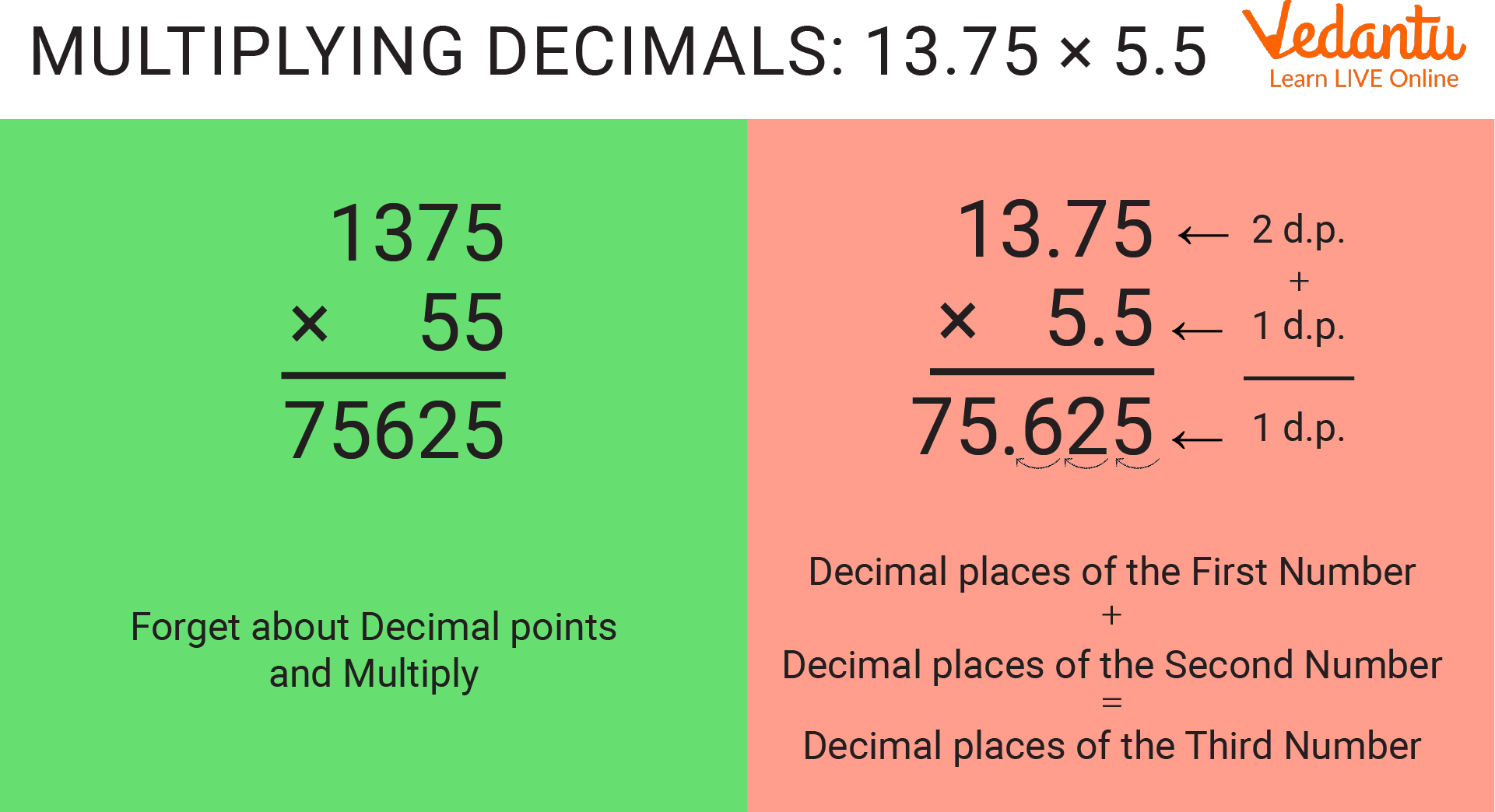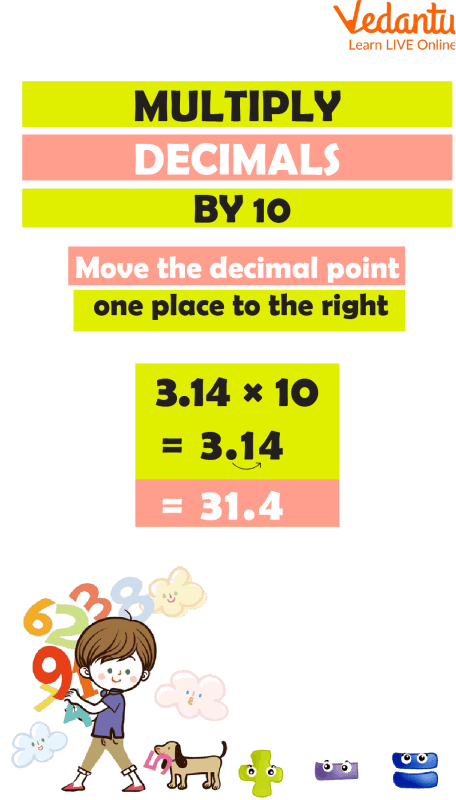




Step-by-Step Guide: How to Multiply Decimals Confidently
The placement of the decimal point differs from how you multiply whole numbers when dividing decimals. A decimal is multiplied by a whole number exactly like a whole number, but the decimal point is added. Multiplying decimals results in a decimal point. This result has a total of ten decimal places. The placement of decimal points differs from multiplying whole numbers. Keep reading to know more about decimal multiplication.

Multiplying Decimals
How Do Decimals Work?
A fractional point (also called a 'decimal separator') separates the whole part from the fractional part of a number with a point or a dot. However, in the UK, children are taught to write a point as the decimal separator, as opposed to a comma. To help children understand decimal numbers, the connection between decimal numbers and fractions will be discussed in the next section.
Calculating Decimal Multiplication Using Whole Numbers
The only difference between multiplying decimals with whole numbers and multiplying them with decimals is where the decimal point is placed. You can perform this operation by following these steps:
Step 1: Multiply the two numbers without the decimal point at first.
Step 2: Once you have multiplied the fractional number, count how many decimal places there are. The product will have the same number of decimal places when you divide two numbers.
Step 3: Add the decimal point to the result obtained in Step 2.
For example,
$6.7281 \times 10 =67.281$
$6.7281 \times 100 =672.81$
$6 .7281 \times 1000 =6728.1$
This applies when you procreate by multiples of 10.
For sample:
50 × 2.5 = 5 × 10 × 2.5 = 5 × 25 = 125
Multiplying Two Decimal Numbers
Multiplying two-digit decimal numbers will be explained in this section. We have to sum up the decimal places in both the whole number and the product, which must equal the sum of the decimal places in each given number.
The following are the steps for multiplying two decimal numbers:
Step 1: Multiply the two numbers normally without the decimal point.
Step 2: After multiplying, see how many decimal places there are in both numbers. This is the number of decimal places in the product obtained after dividing two numbers.
Step 3: Add a decimal point to the result based on Step 2.
Let’s check an example:
Step 1: Multiply the two figures as two whole calculations.
36 × 13 = 468.
Step 2: Currently, there's one number each after the decimal point in the factors.
So, 3.6 × 1.3 = 4.68.
Factor 3.6 can be compared to 4 and 1.3 to 1. Thus, their produce can live valued to be 4. This will help you in certifying the placement of the decimal point.
The Multiplication of Decimals by Ten, One Hundred, and One Thousand
A decimal multiplied by 10, 100, 1000, or any other power of 10 simply shifts the decimal point to the right in as many places as the number of zeros.
As the number 10 has 1 zero, the decimal point shifts one place towards the right when we multiply by 10.
The decimal point shifts two places to the right when we multiply a decimal by 100.
In the same way, a decimal point shifts three places to the right after getting multiplied by 1000.
The following example, 2.32 × 10 = 23.2, 2.32 × 100 = 232, 2.32 × 1000 = 2320.

Multiplying Decimals by 10
Calculate the value of 4.469 by multiplying it by 10. Then multiply 4.469 by 100. The final step is to multiply 4.469 by 1,000.
$4.469 \times 10 = 44.690$
$4.469 \times 100 = 446.900$
$4.469 \times 1000 = 4469.000$
How to Multiply Decimal Numbers?
To multiply the decimals together, arrange them in a line. Ignore the decimal and multiply the decimals as if they were conventional numbers. The decimal places in each of the two numbers are counted. How many times you move the decimal in your solution depends on the number of decimal places in the decimal.
Summary
Decimals are needed for multiplying and dividing. If you have worked with whole numbers, you will work with decimals as well, but you will need to understand where the decimal point is. As a result of multiplying decimals, the product contains the same number of decimal places as the factors. We hope you found sufficient help with this article and we were able to resolve your queries, you can visit our website to try out Maths worksheets to enhance your Mathematics skills.
FAQs on Decimal Multiplication Made Simple for Students
1. What is the basic step-by-step method for decimal multiplication for kids?
Multiplying decimals is a simple process if you follow these steps:
Step 1: Ignore the decimal points for a moment and multiply the numbers as if they were whole numbers.
Step 2: Count the total number of digits that come after the decimal point in both of the original numbers you are multiplying.
Step 3: In your answer (the product), place the decimal point so that it has the same number of digits after it as the total you counted in Step 2.
For example, to multiply 2.5 by 0.3, first multiply 25 × 3 = 75. The original numbers have two decimal places in total (one in 2.5 and one in 0.3), so the answer is 0.75.
2. How do you multiply a decimal number by a whole number?
To multiply a decimal by a whole number, you follow the standard rules. First, multiply the numbers without considering the decimal point. Then, count the number of decimal places only in the decimal number. Place the decimal point in the final product so it has that same number of decimal places. For instance, to calculate 4.25 × 3, you multiply 425 × 3 to get 1275. Since 4.25 has two decimal places, the final answer is 12.75.
3. Why does multiplying two decimal numbers (like 0.5 × 0.4) result in a smaller number?
This happens because multiplying by a decimal less than 1 is like finding a fraction or a part of a number. For instance, 0.5 is the same as one-half. So, when you multiply 0.5 × 0.4, you are essentially asking, "What is half of 0.4?" The answer, 0.20, is naturally smaller than the number you started with. It's a key concept showing that multiplication doesn't always make numbers bigger.
4. What is a real-world example of where we use decimal multiplication?
Decimal multiplication is very important in everyday life, especially when dealing with money and measurements. For example, if you are buying 2.5 kilograms of vegetables that cost ₹40.50 per kilogram, you would need to multiply 40.50 by 2.5 to find the total bill. This shows how decimal multiplication helps in calculating costs, distances, weights, and more.
5. What is the trick for multiplying decimals by 10, 100, or 1000?
There's a very simple shortcut. To multiply a decimal by 10, 100, or 1000, you just need to move the decimal point to the right. The number of places you move it is equal to the number of zeros in the multiplier:
To multiply by 10 (one zero), move the decimal point one place to the right (e.g., 6.78 × 10 = 67.8).
To multiply by 100 (two zeros), move it two places to the right (e.g., 6.78 × 100 = 678).
To multiply by 1000 (three zeros), move it three places to the right (e.g., 6.78 × 1000 = 6780).
6. What happens if the product doesn't have enough digits for the decimal point, like in 0.4 × 0.2?
This is a great question and a common point of confusion. Here's how to handle it: First, multiply the numbers as usual: 4 × 2 = 8. Next, count the total decimal places in the original numbers (0.4 has one, and 0.2 has one, so that's two total). Your answer, 8, must have two decimal places. Since '8' is only one digit, you need to add a placeholder zero in front of it. So, the correct answer is 0.08.
7. How is the rule for placing the decimal point different in multiplication versus addition?
The rules are completely different and it's important not to mix them up.
- In addition and subtraction, you must first align the decimal points of the numbers vertically before you add or subtract.
- In multiplication, you ignore the decimal points initially. You only use them at the very end by counting the total decimal places in the numbers you multiplied to position the decimal in the final answer.

















